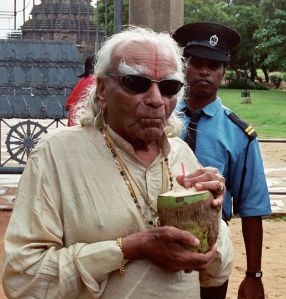
This is such as great article by Iyengar Home Practice that I wanted to share it with you. I also recommended visiting the Iyengar Home Practice website to read the many replies the post inspired and as a wonderful resource on all things Iyengar. Click here to access article directly. Happy reading, Simone
Clearing up a few misconceptions about Iyengar yoga

Now that the world’s attention has focused more on Iyengar yoga since his passing, I would like to take this opportunity to clarify some misconceptions about this style that I have seen in various blogs and social media.
Misconception #1: Iyengar yoga is prop based.
First, pick up a copy of Light On Yoga. You won’t find a single prop in his presentation of over 200 asanas…save a blanket and bench and a Noelle Perez-Christiaens. Iyengar designed the use of props to get students further into certain actions of the pose, and for those who could not otherwise attain the pose without supports. Further prop refinements, particularly in Salamba Sarvangasana (supported all limbs pose, or Shoulderstand) uses blankets for safety issues.
When Iyengar teachers go for assessment, we are advised to do and teach asanas without props in the middle of the room unless otherwise specified. Props are only used to get the student to do the correct “actions” of the classic asana. Once the actions are learned and mastered, we get rid of the props.
That being said, the use of props is to allow us to spend more time in asana. In an interview, Iyengar says that the Lion-diety Narasimha inspired him to use straps as devotional statues show that he used the prop to sit in meditation for long periods of time.
Misconception #2: Iyengar teachers are mean.
Iyengar was quite stern in his teaching. One of my students who took a class from him in the 80s when he visited Hawai’i could not remember what he taught, but she did remember that he was strict. We are taught to say instructions in a verb-noun format like “extend your arm!” This may have a “drill sergeant” sound to it, but when you are in a precarious spot in an asana would you rather hear “softly guide your inner spirit into the pose” or “press your thighs up to take strain off your neck?” One senior teacher said that once class ended, Iyengar was the nicest man you’ve ever met. Is the photo below that of a “mean” teacher? Don’t confuse “strict” for “mean.”
Misconception #3: Your first Iyengar class will tell you everything there is to know about this style.
In our studio, we have a five week cycle of classes. Week 1 is standing poses, week 2 is forward bends, week 3 is backbends, week 4 is miscellaneous which usually covers twists, and arm balances, and week 5 is restorative and pranayama. For the person who just shows up one time on restorative week, they will think all Iyengar yoga is about is lying around and breathing. Conversely if they come only on standing pose or backbend week, they will think we are too physical. It will take a student about three months of regular practice just to understand the basic underpinnings of the system. In our fast food Yelp culture, three months is too long. We demand results now! Iyengar yoga is quite subversive to Western culture. It requires discipline. It requires time…like years not days or months.
Misconception #4: Iyengar yoga is for old people.
I will admit that there tends to be more older people in Iyengar classes than in other styles. Early in the US yoga craze, there was a studio who would send all of its prospective teachers to an Iyengar teacher who taught in the same area. All the prospective teachers were young and lithe and new to yoga. I would hear them all complain that there were too many “old” people in the class. When it was time for Sarvangasna, the younger students all had a banana shape, whereas the “old” students had straight spines and were not as jittery in the pose. Many of the prospective teachers did not return. What they did not know is that many of the “old” students had been practicing since their 20s or 30s and were well into their 50s and 60s.
Older people are drawn to this style for several reasons. The first is that it is safe. Teachers take great pains to learn how to get students safely in and out of poses and to make modifications for those who cannot attain the pose. Secondly, it is a discipline. It takes the patience of a mature practitioner to understand the depth of this style. As mentioned before, this does not come overnight. Lastly, the “old” people in class are the ones with the best poses. In Light On Yoga, Guruji is in his 50s.
That being said, our studio has a “yoga for kids” class. There is also a famous class at RIMYI on Sundays that caters to children only. In my instruction to my nieces who are 3 and 8, I have found that they love to use the props and find the practice challenging.
Misconception #5: Iyengar classes are for injured people
There is a part of our practice that deals with therapeutics. We have many sequences to address particular ailments. There is even a “medical class” taught at RIMYI. In a sense, that has clouded the perception that this style is for injured people. I find it sad that this is the only way people find this style of yoga. The reality is that asanas when done properly are healing. But the teachings show us to get beyond that and venture to the inner work of the parts of us that are beyond injury: the breath the mind and the soul.
Misconception #6: Iyengar yoga is slow and boring
Iyengar yoga, when taught properly, is more instructional than experiential. The idea behind this style is eventually the practitioner will do a home practice to further what was learned in class. That is when you truly experience the beauty in this teaching. In an era of power vinyasa yoga, our classes appear slow. There is a part of our practice where Surya Namaskar is done, it’s just not every class. As seen above, there are many areas of this style. Some are faster than others.
This style is anything but boring. I have over 60 posts and have not even scratched the surface of this subject. The famous late teacher Mary Dunn would comment that the learning curve for Iyengar yoga is always straight up. There are no plateaus to the depth of this teaching.





